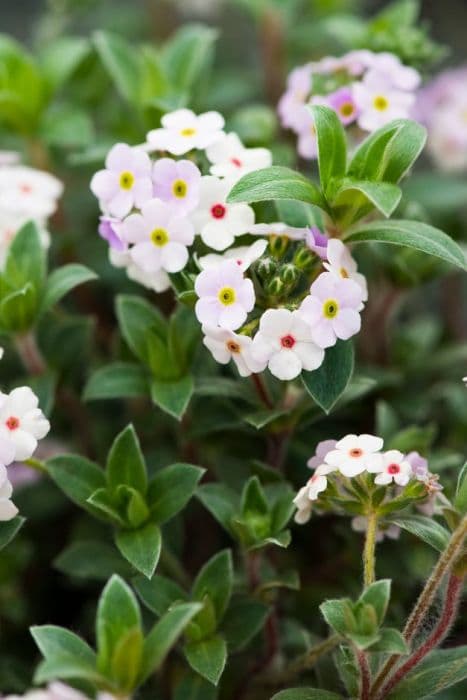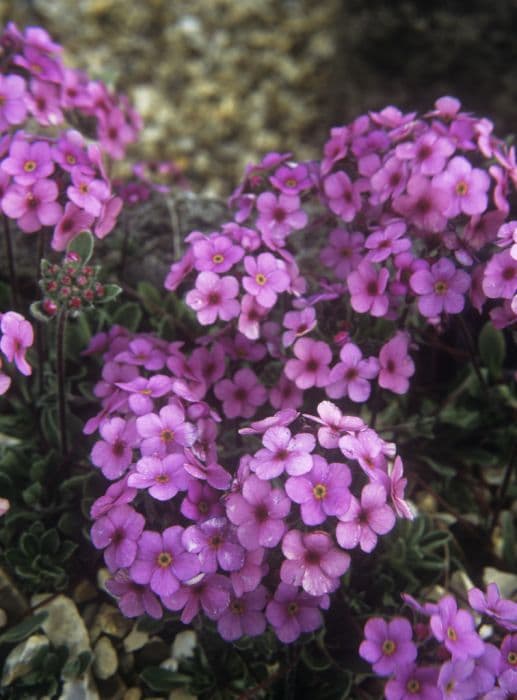Japanese Primrose Primula sieboldii 'Ginfukurin' (Co)

ABOUT
Primula sieboldii 'Ginfukurin' is a variety of primrose that presents itself with quite charming attributes. The plant bears round, somewhat lobed leaves that form a lush, green rosette as its foundation. Surrounding these leaves, you will notice a distinctive feature—each leaf often exhibits a creamy or yellowish edge, which gives the plant its name 'Ginfukurin,' suggesting a 'silver edged' appearance. Above the foliage, delicate stems stretch upward, culminating in clusters of enchanting flowers. These blossoms are irresistibly attractive and come in a range of shades from white to various pinks, and sometimes may even display a soft lavender hue. The petals exhibit a distinct form; they are rounded with a slight notch at the tip, which gives each flower a gentle, frilled look, enhancing the overall delicate aesthetic. To add to the allure, often the petals have a gradation of color, with the centers carrying a deeper tone that softly diffuses outwards to lighter margins. The center of each flower is also often highlighted with a yellow or golden eye, providing a lovely contrast with the pastel petals and drawing in the gaze of any onlooker. The primrose graciously arranges these floral clusters atop its foliage, creating a delightful spray of color in the spring and early summer months, when it typically blooms. Each flower seems to float above the leaves, adding a charming touch to the garden landscape. Overall, Primula sieboldii 'Ginfukurin' offers a captivating display with its beautifully variegated foliage and its sweet, soft-colored flowers.
About this plant
 Names
NamesFamily
Primulaceae
Synonyms
Japanese Primrose, Siebold's Primrose, Ginfukurin Primrose
Common names
Primula sieboldii 'Ginfukurin'.
 Toxicity
ToxicityTo humans
Primula sieboldii, commonly known as Japanese primrose, is not generally considered toxic to humans. There are no well-documented reports of significant toxic effects from ingesting this plant. However, it is always advisable to exercise caution and avoid eating plants not known to be safe for consumption. In the rare event that someone does experience discomfort or adverse symptoms after ingesting any part of the Japanese primrose, it is recommended to seek medical advice.
To pets
Japanese primrose is also not known to be toxic to pets. While the ingestion of non-food items by pets should be avoided, there are no significant reports of poisoning or severe health consequences from pets consuming the Japanese primrose. If you suspect your pet has ingested this plant and is showing signs of illness, such as vomiting or diarrhea, it is best to consult a veterinarian.
 Characteristics
CharacteristicsLife cycle
Perennials
Foliage type
Deciduous
Color of leaves
Green
Flower color
Varies
Height
0.5 feet (15 cm)
Spread
0.5 feet (15 cm)
Plant type
Herb
Hardiness zones
5
Native area
Asia
Benefits
 General Benefits
General Benefits- Aesthetic Appeal: Adds vibrant colors and decorative patterns to gardens and indoor spaces.
- Habitat Support: Provides nectar for pollinators like bees and butterflies, supporting local ecosystems.
- Low Maintenance: Requires minimal care once established, making it suitable for busy gardeners or those new to gardening.
- Seasonal Interest: Offers seasonal blooms that can rejuvenate and enhance the appearance of a garden landscape.
- Adaptability: Capable of growing in a variety of conditions, including partial shade and well-draining soil.
- Versatility: Can be used in different garden settings, such as borders, rock gardens, and containers.
- Rarity & Collectibility: Being a cultivar, it may be sought after by plant collectors and enthusiasts for its unique characteristics.
- Non-Invasive: Unlike some plants, it’s not known to be invasive and won’t overtake other plants in the garden.
 Medical Properties
Medical PropertiesThis plant is not used for medical purposes.
 Air-purifying Qualities
Air-purifying QualitiesThis plant is not specifically known for air purifying qualities.
 Other Uses
Other Uses- Primula sieboldii 'Ginfukurin' can be used in floral art and arrangements due to their colorful and attractive blooms that can add a delicate touch to any creation.
- The blossoms can also be used to decorate food, as they are edible and can add a floral flair to salads and desserts.
- This plant can serve as a natural indicator of the changing seasons, as it flowers in the spring, signaling the end of winter.
- The leaves of the plant can be used for crafting, either pressed in books to create botanical paper items or included in resin jewelry for a nature-inspired design.
- In photography and painting, the bloom can be an exquisite subject due to its intricate patterns and soft color palette.
- Used in educational settings, it can help teach botany and horticulture, especially regarding reproduction and growth patterns of perennial plants.
- For hobbyist gardeners, collecting different varieties of Primula, including Primula sieboldii 'Ginfukurin', can become a rewarding pastime.
- They can also be used in butterfly gardens to attract and support local butterfly populations, as many primulas are a nectar source for these insects.
- In landscape design, this plant's varying leaf variegation and flower color can be used to create visually appealing textures and vibrant pops of color.
- Lastly, the plant's preference for shady areas makes it an excellent choice for underplanting beneath taller plants or trees, helping to cover bare ground.
Interesting Facts
 Feng Shui
Feng ShuiThe Japanese Primrose is not used in Feng Shui practice.
 Zodiac Sign Compitability
Zodiac Sign CompitabilityThe Japanese Primrose is not used in astrology practice.
 Plant Symbolism
Plant Symbolism- Enduring Love: The delicate yet persistent nature of Primula sieboldii, also known as Japanese Primrose, symbolizes a love that is resilient and everlasting.
- New Beginnings: Associated with spring, the Japanese Primrose represents rebirth and the start of new ventures.
- Happiness and Joy: Often found in bright colors, these cheerful flowers can signify happiness and the simple joys in life.
- Hope: As one of the first flowers to bloom in spring, the Japanese Primrose signifies hope and the belief in a better future.
- Transformation: The plant's cycle of blooming anew each spring is symbolic of personal growth and transformation.
 Water
WaterThe Japanese Primrose should be watered thoroughly to ensure the soil is moist but never waterlogged. Typically, it should be watered once a week, but this may vary based on the humidity and temperature. Increase the frequency of watering during the growing season in spring and summer, and reduce it in the cooler fall and winter months. When watering, apply about half a gallon of water to the base of the plant, avoiding water on the foliage to prevent any potential disease issues.
 Light
LightJapanese Primrose thrives in partial shade, where it can receive gentle morning sunlight but is protected from the harsh afternoon rays. A spot that offers dappled sunlight, perhaps under a tree or beside taller plants that can provide intermittent shade, is ideal. Avoid placing it in full sun as it can lead to leaf scorch and stress the plant.
 Temperature
TemperatureJapanese Primrose prefers cooler conditions and can survive in temperatures ranging from as low as 20°F to as high as 80°F. However, its ideal growing temperature is between 50°F and 70°F. Freezing temperatures can damage or kill the plant, so it should be protected or moved indoors when cold weather is anticipated.
 Pruning
PruningPruning the Japanese Primrose helps to maintain its shape and encourages healthier growth. It should be pruned after flowering to remove dead or faded flowers and encourage a second bloom. Typically, it is best to prune in late spring to early summer. Simply snip off the spent flowers at the base of their stems and any damaged or diseased foliage.
 Cleaning
CleaningAs needed
 Soil
SoilFor the Japanese Primrose, a soil mix that drains well and is rich in organic matter is ideal. The best mix would consist of loam, peat, and perlite in equal parts, ensuring good aeration and moisture retention. The soil pH should be slightly acidic, around pH 5.5 to 6.5, for optimal growth.
 Repotting
RepottingJapanese Primrose should be repotted every one to two years. The best time for repotting is after flowering when the plant is entering a period of dormancy.
 Humidity & Misting
Humidity & MistingJapanese Primrose thrives in moderate to high humidity levels, ideally around 50% to 60%. They can tolerate lower humidity levels, but prefer consistently moist air.
 Suitable locations
Suitable locationsIndoor
Place in bright, indirect light, keeping the soil moist.
Outdoor
Partial shade, keep soil moist, protect from harsh sun.
Hardiness zone
4-8 USDA
 Life cycle
Life cyclePrimula sieboldii 'Ginfukurin' (Co), commonly known as Japanese woodland primrose or Siebold's primrose, begins its life cycle as a seed that germinates in late winter to early spring. The seedling develops into a rosette of leaves that grow close to the ground, conserving energy for the upcoming season. In spring, the plant sends up flowering stems with clusters of elegant, fringed, pale-pink flowers, attracting pollinators such as bees and butterflies. After pollination, the flowers produce small capsules containing numerous tiny seeds, which are dispersed by wind or water. The plant then goes into dormancy during the summer, with the foliage dying back to preserve moisture and energy. In the fall, the cycle is ready to begin anew, with the rosette re-emerging and preparing for the next growth cycle.
 Propogation
PropogationPropogation time
Spring to summer
Primula sieboldii 'Ginfukurin', commonly known as Siebold's Primrose, is often propagated during late winter to early spring before new growth begins. The most popular method of propagating Siebold's Primrose is by division. This involves gently separating the plant into smaller sections, making sure that each section has a portion of the root system. It is crucial to do this with care to minimize damage to the roots. Dividing the plant helps to rejuvenate older clumps that may have become woody or less vigorous in the center. Once divided, the segments can be immediately replanted into well-prepared soil, ensuring they are watered adequately to establish a strong root system. This method is a simple and effective way to create new plants that will bloom in the following seasons.









